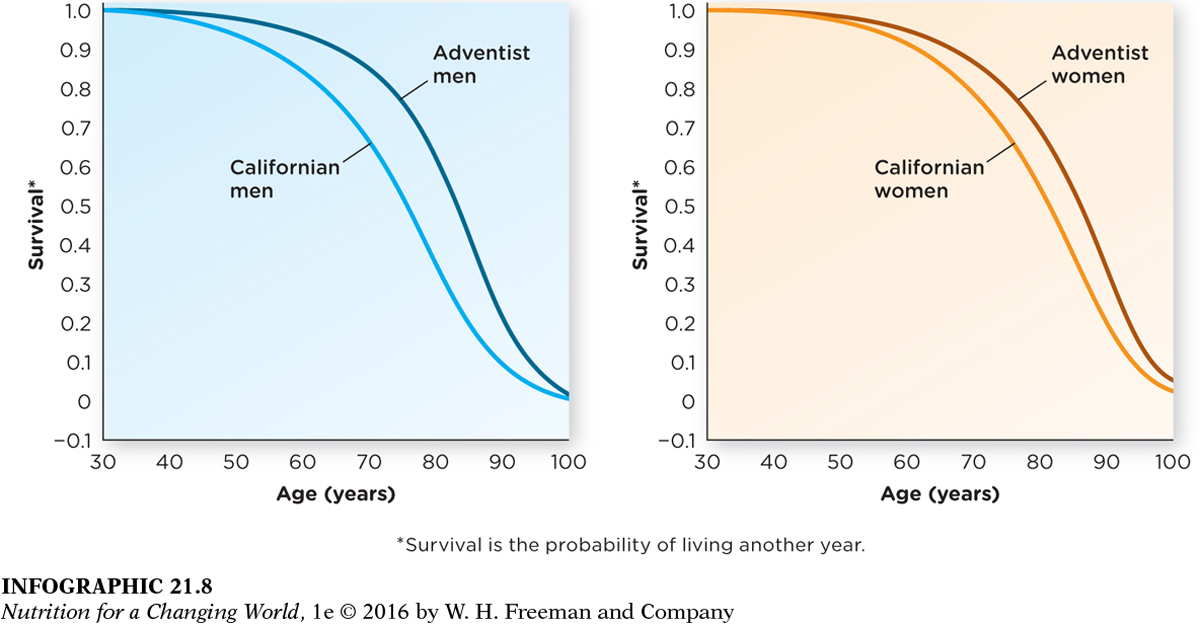STUDYING THE ADVENTIST LIFESTYLE FOR CLUES TO LONGEVITY
Though it makes intuitive sense that cutting out known risk factors for disease, like smoking and drinking, would improve health (and it is fairly easy to show this empirically), dissecting the nutritional contributions to health and longevity is a bit more difficult. It requires large, carefully planned studies that are statistically powered to detect subtle effects of dietary variables.
The first study to look at the nutrition of Adventists was the Adventist Health Study, which began in 1976. This study analyzed the health-related behaviors of 34,192 Adventist men and women 30 years and older. (The individuals in this study were all non-Hispanic whites, although later studies have included Hispanics and African Americans as well.) Individuals filled out a detailed questionnaire and the researchers made follow-up contact until 1988. The Adventists’ dietary choices were assessed by asking about how often they consumed 55 different foods or food groups. Exercise levels were assessed and scored with a similar battery of questions. Study participants were contacted each year to ascertain any hospitalizations and other health information, such as heart attacks or cancers. Height and weight measures provided by participants were used to calculate body mass index (BMI).
From this information, the study investigators then analyzed the relationship between individuals’ behaviors and their risk of disease and death. The result? Certain behaviors practiced by a subset of Adventists were associated with clear benefits to health and longevity. Being physically active, eating lots of nuts, being vegetarian, and having a healthy BMI each provided approximately 1.5 to 2.5 years of extra expectancy. The boost to longevity was additive, with longevity increasing to a greater extent as Adventists practiced a greater number of these behaviors. The average life expectancy (at age 30) of Adventist men and women was 81.2 and 83.9 years, respectively. This corresponds to an extra 7.3 years of life for Adventist men and an extra 4.4 years for Adventist women, when compared with other Californians.
505
When just the Adventist vegetarians were used as the basis of comparison, the difference was even more striking: Adventist vegetarian men and women had a life expectancy that was 9.5 and 6.1 years, respectively, longer than their fellow Californians.
The authors of the study, published in 2001, conclude, “These results strongly suggest that behavioral choices influence the expected age at death by several years, even as much as a decade.” (INFOGRAPHIC 21.8)

Question 21.8
 How much more likely to survive is a 70-year-old Adventist man than a 70-year-old Californian man? What about a 70-year-old Adventist woman compared with a 70-year-old Californian woman?
How much more likely to survive is a 70-year-old Adventist man than a 70-year-old Californian man? What about a 70-year-old Adventist woman compared with a 70-year-old Californian woman?
The Adventist man has a 0.9 (or 90%) probability of living another year versus 0.65 (65%) for the California man. The Adventist woman has a probability of 0.95 (95%) of living another year versus 0.8 (80%) for the California woman.
Why men experience more of a benefit is not entirely clear. There is some evidence that men, in general, tend to make worse dietary choices than women, so their nutritional deficits might be more easily corrected, explains Fraser.
The Adventist studies (there are now several) have unique advantages, not least of which is the fact that the study population is relatively homogeneous with regard to smoking and drinking (they abstain). This allows study investigators to isolate the nutritional variables that seem to affect health outcomes with a greater amount of certainty. “These people are very similar in other respects, except for the way that they eat,” says Fraser.